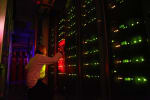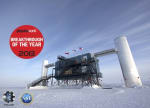Our Milky Way galaxy is an awe-inspiring feature of the night sky, viewable with the naked eye as a horizon-to-horizon hazy band of stars. Now, for the first time, the IceCube Neutrino Observatory has produced an image of the Milky Way using neutrinos—tiny, ghostlike astronomical messengers. In an article to be published tomorrow, June 30, […]
Press Releases
IceCube neutrinos give us first glimpse into the inner depths of an active galaxy
For the first time, an international team of scientists have found evidence of high-energy neutrino emission from NGC 1068, also known as Messier 77, an active galaxy in the constellation Cetus and one of the most familiar and well-studied galaxies to date. First spotted in 1780, this galaxy, located 47 million light-years away from us, […]
IceCube detection of a high-energy particle proves 60-year-old theory
On December 8, 2016,* a high-energy particle called an electron antineutrino hurtled to Earth from outer space at close to the speed of light carrying 6.3 petaelectronvolts (PeV) of energy. Deep inside the ice sheet at the South Pole, it smashed into an electron and produced a particle that quickly decayed into a shower of […]
NSF mid-scale award sets off the first extension of IceCube
The National Science Foundation (NSF) has approved full funding to upgrade the IceCube detector, extending its scientific capabilities to lower energies and thus enabling IceCube to reach neutrino energies that overlap with the energy ranges of smaller existing neutrino detectors worldwide. […]
IceCube neutrinos point to long-sought cosmic ray accelerator
Observations made by the IceCube Neutrino Observatory at the Amundsen–Scott South Pole Station and confirmed by telescopes around the globe and in Earth’s orbit have for the first time provided evidence for a known blazar as a source of high-energy neutrinos. These results are presented in two papers published this week in the journal Science. […]
A first look at how the Earth stops high-energy neutrinos in their tracks
Neutrinos are abundant subatomic particles that are famous for passing through anything and everything, only very rarely interacting with matter. Now, scientists have demonstrated that the Earth stops very energetic neutrinos—they do not go through everything. The study is published online today by the journal Nature. […]
IceCube search for the ‘sterile neutrino’ draws a blank
In an effort to fill in the blanks of the Standard Model of particle physics, science has been conducting a diligent search for a hypothesized particle known as the “sterile neutrino.” Now, with the latest results from an icy particle detector at the South Pole, scientists are almost certain that there is no such particle. […]
NSF renews IceCube maintenance and operations contract
The National Science Foundation today, March 30, 2016, announced that it has renewed a cooperative agreement with the University of Wisconsin–Madison to operate IceCube. The five-year, $35 million award entails the continued operation and management of the observatory located at NSF’s Amundsen-Scott South Pole Station. In 2013, the IceCube Collaboration reported the first detection of high-energy cosmic neutrinos, opening a new astronomical vista on the universe and on some of its most violent phenomena. […]
IceCube confirms the astrophysical nature of high-energy neutrinos with an independent search in the Northern Hemisphere
Today, the IceCube Collaboration announces a new observation of high-energy neutrinos that originated beyond our solar system. This study, which looked for neutrinos coming from the Northern Hemisphere, confirms their cosmic origin as well as the presence of extragalactic neutrinos and the intensity of the neutrino rate. The first evidence for astrophysical neutrinos was announced by the collaboration in November 2013. The results published now in ”Physical Review Letters” are the first independent confirmation of this discovery. […]
IceCube awarded the 2013 Breakthrough of the Year
The IceCube project has been awarded the 2013 Breakthrough of the Year by the British magazine Physics World. The Antarctic observatory has been selected for making the first observation of cosmic neutrinos, but also for overcoming the many challenges of creating and operating a colossal detector deep under the ice at the South Pole. […]









